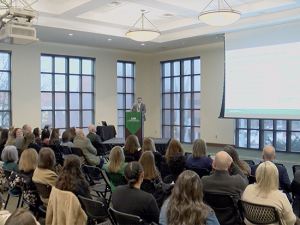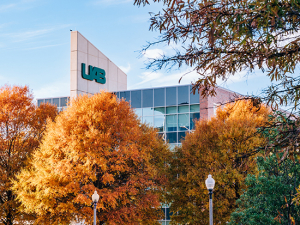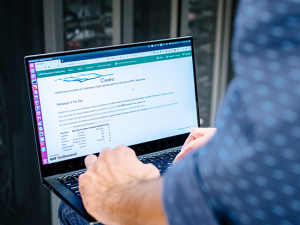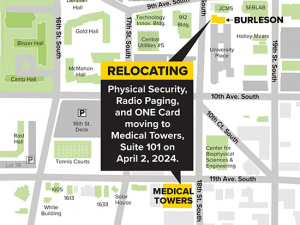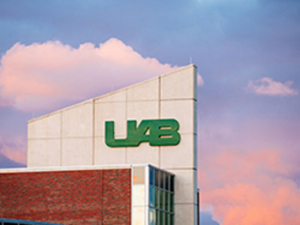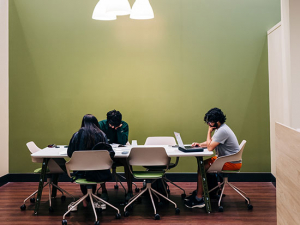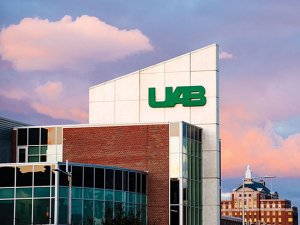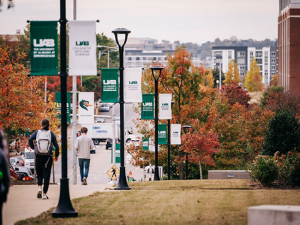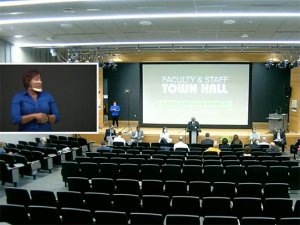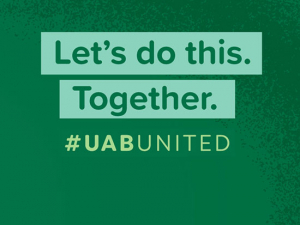In a campuswide virtual town hall meeting Thursday, President Ray Watts and other senior leaders shared the latest information on UAB's expense reduction efforts, planning for a safe return for all employees and students, COVID testing, vaccines and more.
Here, we recap those updates and answers to some of the nearly 300 questions submitted by staff and faculty. We've also collected the answers to many of the questions that couldn’t be addressed in the hour-long event. (Watch the full town hall video below.)
(Jump to answers to specific categories of questions below, or read on for the full summary.)
Re-opening: When will UAB be able to bring employees and students back?
- UAB Transition Back Task Force
- Back-to-campus questions
- Restarting research
- Health System Task Forces
Financial modeling and budget timelines
COVID diagnosis and antibody testing
Expense reductions due to COVID-19 crisis
“Earlier this week we announced some additional expense reductions to deal with a projected loss of over $40 million for the university and almost $230 million for the health system through the end of the fiscal year [Sept. 30, 2020],” Watts noted in his opening comments.
To date, UAB and UAB Medicine have been able to largely sustain uninterrupted payroll for more than seven weeks as UAB instituted its limited business model. This has included “a wide range of expense reductions” to close those expected budget shortfalls, Watts said. As noted in an institutionwide email sent Monday from Watts and UAB Health System CEO Will Ferniany, university leaders “explored many options with advisory panels across campus,” including Faculty Senate and Staff Council leaders, the university’s Budget Advisory Committee and other groups. In parallel, “UAB Medicine gathered input from leaders across the organization and its governing bodies to determine expense-reduction strategies.”
With reluctance, the university and UAB Medicine announced temporary furloughs for approximately 325 UAB employees, to extend from May 10 to July 31. During that time, “we will maintain everyone’s benefits,” Watts said during the town hall. University and health system leaders had their salaries reduced for at least the remainder of the fiscal year, including 15% reductions for the president and the Health System Executive Cabinet; 10% for senior vice presidents and UAB Medicine senior leaders, including department chairs; and 7% for deans and vice presidents.
Temporary salary reductions for many clinical faculty and Workgroup C staff in UAB Medicine and Health System-managed entities also were announced.
“If we can bring back people sooner or restore full salaries sooner, we will do so,” Watts pledged during the town hall.
In his remarks, Health System CEO Ferniany said he was committed to the same pledge to employees that Watts had made. “If we can pay these dollars back when our finances become available we will,” Ferniany said. “We need to get the hospital open as quickly and as safely as possible.”
Furlough questions:
Q: Have all furloughed employees been notified at this point?
There are two groups of employees with Workgroup A who are among the roughly 325 UAB employees who will be furloughed, Bolton explained.
The first group are employees in Workgroup A, Group 3. “They were the employees unable to work remotely and were not considered essential to be on campus at this time,” Bolton said. “All of those employees have been notified.”
The second group are individuals in Workgroup A, Group 2, who “were tasked to work remotely and their supervisors were asked this week to identify those who have been unable to work effectively and efficiently,” Bolton said. “We have the lists of those employees from the supervisors as of today.” All of these employees will be notified by their supervisors by end-of-business Friday, May 8, Bolton said.
“On Monday evening after the Group 3 individuals received their notifications, our HR team stayed here and made phone calls to every individual on the list to answer their questions and just to provide a personal outreach,” Bolton noted. “Certainly they were not able to reach everyone but they reached the vast majority on that list and they'll do the same with the notifications that are going to occur today and Friday.”
Q: How will I be notified if I am furloughed?
You will get an email notification from your supervisor and a call from Human Resources by Friday, May 8, Bolton said.
Q: How do we find out which group we are in?
Employees can check their workgroup on the Human Resources site or on the MyUAB portal. “If you have multiple assignments with multiple workgroups it will indicate the workgroup for each assignment,” said Chief Human Resources Officer Alesia Jones.
Employees in Workgroup A can contact their supervisors if they are not sure if they are in Group 1, 2 or 3.
Q: Are other categories of workgroup being considered as part of the sliding-scale salary decrease?
“All options have been discussed as we go through the process,” Bolton said. “At this time there is no intent to involve Work Groups A or F in those salary reductions. I will say that leadership did take reductions at the university and Health System.”
The following questions were submitted during the town hall but time did not permit answering during the event. The answers below have been provided by UAB leadership.
Q: What is the total number of furloughs?
Approximately 325 (the original estimate shared accounted for anticipated Group 3 and Group 2 furloughs)
Q: Is retirement time accrual affected (paused?) during furlough?
Yes, retirement time is paused. Furloughed employees will not receive retirement service credit for the furlough period.
Q: How soon will UAB file unemployment for furloughed workers?
UAB will submit the file on the employee’s behalf. Click here to learn more and start that process. We can file after the employee has been without pay/not worked for a full week.
Q: What other factors (other than inability to work remotely) were used in determining which employees have been furloughed? What if you think an error has been made?
Individuals were furloughed who – by the nature of their work – cannot do their job remotely or who serve in a role for which demand decreased or would decrease to a critical point during the furlough period due to the limited business model. Supervisors, who are asked to assess current and anticipated workloads and be responsible stewards of state resources, have discretion in assessing the essential or non-essential nature of someone’s work. If you think a mistake was made, you can talk to your supervisor and/or your dedicated HR representative.
Q: Can you use sick/vacation time during furlough?
No. Access more information and resources for furloughed employees online.
Q: Is sick/vacation time still accruing for furloughed workers?
No. Access more information and resources for furloughed employees online.
Other expense-reduction questions:
Q: Is there a rough estimate of savings by not having the buildings fully staffed?
“I just got a preliminary report last evening,” Bolton said. “For the month of April alone, the utility savings is about $380,000. We are tracking that information and it is part of the savings estimates that have been factored in for the budget gap closure that we need to do between now and the end of the year.”
Q: What are potential next steps in cost-cutting measures?
“That's what we've asked the schools to provide to us by May 15,” Bolton said. “We had gotten a preliminary list of those from the schools five or six weeks ago and we asked them between now and May 15 to sharpen their pencil and tell us what is most actionable between now and the end of the fiscal year.”
Q: Is the employee educational assistance benefit going to change or be cut?
“The educational assistance benefit has not changed,” Jones said. “It applies like it always has for our employees and their dependents. There's no change there.
Q: What about other employee assistance?
“The employee assistance as offered through the Employee Assistance and Counseling Center is also still operational,” Jones said. “They are seeing clients remotely and they are remaining very busy. We always encourage anyone who needs their services, please refer them there. They are doing a great job.”
Q: Will you continue to charge for parking?
“For the employees who remain on the payroll for this period we'll continue to charge for parking,” Bolton said. “The costs are fixed and part of our infrastructure. The costs do not go away even for limited business operations. For the employees on furlough they will not be charged during that period of time.”
Q: Do you envision any changes to the Teacher’s Retirement contributions?
“We are not anticipating any changes to the TRS contributions,” Bolton said.
Q: Will maternity leave be affected?
“I don't anticipate any of the paid parental leave or the other FMLA leaves would be impacted at all,” Jones said.
Q: Are any of the building projects, such as the new science building, put on hold?
“We have not officially put any projects on hold,” Bolton said. “We have a campus planning and advisory committee that meets quarterly and reviews projects as they come through and maintains the campus master plan. We will be discussing the status of projects at our meeting that is scheduled, I believe, later this month. It is a great question and will be a topic of discussion. For bond issues, we'll look at those based on how quickly we can resume operations.”
Q: Will the hiring freeze be lifted?
“The hiring suspension on the university side is in place through the remainder of the fiscal year,” Bolton said. “The stated plan is to have it remain in place with the exception process for essential hires.”
Q: Is offering early retirement being considered?
“I'll again say that all options have been discussed,” Bolton said. “That is not a plan being considered for fiscal year 2020. When we build our budget for fiscal year 2021 all options will be on the table if necessary. So there has been some discussion of it, but no firm plan at this point.”
Q: When are UAB Medicine employees, faculty and staff going to be notified of their salary reductions?
“Each employee will receive an individual letter in the next five to seven days,” Ferniany said. “The retirement deductions are very difficult [to calculate] because of the varieties of plans. So each employee's retirement deductions will be a little different, up to 5%.
Q: Does UAB qualify for funding from the federal CARES Act?
“Yes, we do qualify and we will be receiving stimulus dollars,” Bolton said. “We've already factored that into the gap estimate. The total dollars for the university is about $6 million for the university and an additional $6 million for students that we will be administering.”
“On the UAB Medicine side it's substantial help,” Ferniany said. “Right now it's approximately $60 million. However, as I said before remediation we were about $230 million. So if you take that off that puts us down about $180 million.”
Re-opening: When will UAB be able to bring employees and students back?
Watts and other senior leaders outlined the steps being taken to move toward a resumption of university business, while acknowledging the many unknowns that complicate decisionmaking. “We’re planning on the return to campus as of the fall semester,” Watts said. “But that’s a very fluid situation and there’s a lot to be done between then and now.”
One concerning statistic for Watts: “I would remind you that this virus is still very active. The number of cases in Alabama have gone up 20 percent in the last week.”
The good news “is that our hospital and world-class medical and pathology team has increased our ability to test with a high degree of reliability,” Watts said. “We can do 1,000-2,000 COVID tests a day and we can do at least 1,000 antibody tests each day. Those are highly precise.
“Our public health team and others are working on a plan to be able to use the COVID-19 Tracker System” — a UAB-developed tool at www.helpbeatcovid19.org — “to know the COVID status of our employees and make sure we bring them back safely and we protect our employees,” Watts said.
“We’ll follow all safety guidelines and we’re studying how to begin to bring the faculty and staff back on to campus,” Watts added. Provost Pam Benoit “is leading a campuswide task force,” the Transition Back Task Force, he said. Meanwhile, Senior Vice President and School of Medicine Dean Selwyn Vickers, M.D., is co-chair of the University of Alabama System’s task force.
Q: What if there is a resurgence of the virus?
“Certainly in Jefferson County and in Birmingham, we've taken the strictest positions to limit that and blunt the curve,” Watts said. “The concerning factor is that we've not yet begun to go down. We have 50-60 COVID-positive patients a day in our hospital. There was some trending downward, but not the way we would like for it to. In Jefferson County the incidence is lower than most counties throughout the state, certainly lower than Mobile. In New York City they have begun to flatten but nobody has begun to go down. There is a real likelihood that there could be a resurgence.” That's why continuing with social distancing, hygiene and wearing face masks is so important, Watts said.
“We have to take this very seriously. This virus hasn't gone anywhere. We are going to have to be very rigorous and we have to control our behavior. As you have heard from Dr. Fauci and other experts it's going to be a year or at the earliest nine months [before a vaccine is available]. There is a vaccine that Pfizer has developed and we'll participate in the study coming up soon.”
University's transition team
The Transition Back Task Force began its deliberations with a set of principles derived directly from Forging the Future, UAB’s strategic plan, Benoit said. “We want to preserve the health and safety of our community, maintain and deliver on our mission of engagement and maintain and preserve university operations. We want to treat our community in a fair and equitable manner.” The task force includes subcommittees on students, faculty and staff, research, clinical experiences and communications, Benoit said.
[Benoit also reported on results from the optional pass/fail grading from the spring 2020 semester. Overall, “16.5% chose the pass/fail” option, Benoit said. “There were more undergraduates than graduate students who chose that option. Two of the top schools were Arts and Sciences and Business. We'll collect that information for summer as well.”]
Back-to-campus questions:
Q: When will fall semester begin?
“We're scheduled to be back on Aug. 24,” Benoit said. “There are a number of things being examined. There could be a potential delay of the fall semester. So I can't answer that yet until we get recommendations back from the Transition Back Task Force. People are concerned about what will happen and they want certainty. The difficulty is that this is an evolving situation and we're trying to be responsive to what we learn and make evidence-based decisions.”
Q: For fall classroom teaching, what are your suggestions for faculty that fall in high-risk categories?
“That is being evaluated for faculty — and students also — with underlying conditions that are high risk that can make it difficult for them to return to the classroom,” Benoit said. “One thing we have looked at is if we could offer both synchronous and asynchronous. Could instructors teach that way? Could we have hybrid courses? There are a variety of different options, but we have to think about and make sure we go back to the principle that we're protecting the health of our community and thinking about how one measure is not going to be appropriate for the entire campus.”
Q: What about faculty promotions and pay raises?
“I'm glad to report that we were able to work through that this week and we'll provide promotions and tenure as normal,” Benoit said. “I sent a note to the deans reminding them that they need to keep the tenure and promotion increases in the budget. When they report on the gaps, they need to include any promotions and tenure with that.”
Q: Are there any changes to new visa applications — H1B in particular?
“At this point no, there are no changes in the Office of International Student and Scholar Services,” Senior Vice Provost & Senior International Officer Suzanne Austin said. “We're fully functioning and processes are moving along as they always have.”
Q: What about child-care resources for university employees?
“I would say our Child Care Center will have to follow all state guidelines in terms of reopening,” Bolton said. “And we may also weigh in as well in addition to those guidelines. The safety of the children and the workers is of paramount importance in that setting. We are in very limited operations right now and providing very limited childcare services on a plan that was reviewed and approved by the state and those services are only being provided to the children of front-line health care workers right now.”
The following questions were submitted during the town hall but time did not permit answering during the event. The answers below have been provided by UAB leadership.
Q: What notice will we get before returning? The limited business model announcement was rushed.
The limited business model was implemented quickly in the interest of the health and safety of our campus community in a fluid, evolving situation. As we work toward a safe return to operations, we will give as much notice and guidance as possible based on what we know at the time in the interest of health and safety.
Q: Is there a timeline set for the return of UAB Athletics?
This is unknown at this time, but we will continue to work with the NCAA and Conference USA to collaborate on plans.
Q: Is UAB Athletics represented on the Transition Back Task Force?
Yes, Athletics is involved in the task force.
Q: Will all staff get masks from UAB when we return?
At this time, employees working on campus are being provided masks. This is one aspect of a safe return to campus that is being explored.
Q: Can divisions/departments make their own decisions on when it is safe to return?
No. Any unit/division/department should coordinate with their leadership and Human Resources for appropriate approvals and coordination.
Q: Will there be a fall commencement ceremony?
It is too soon to know, but we hope so. We will communicate updates to the campus as we know them.
Q: Should we expect tuition increases?
There are no plans for tuition increases at this time.
Restarting research
Q: Is there any idea of a timeline for return to nonhuman subjects laboratory research?
“As part of the larger university task force and integrating with the UA System Task Force we are developing our protocols and our phased approach to resumption of research,” Vice President for Research Chris Brown said. “Our goal is to do this with data in mind and risk factors in mind with individuals. Our hope is to have our document and our plan squared away in the next few days and then give people time to get their operational times together for their laboratories, no matter what kind of research they are doing…. We're working hard so that resumption of research will be one of the first things we start back when we resume normal operations.”
Health system task forces
One task force, chaired by Health System Chief Operating Officer Reid Jones, is working “to see how quickly and safely we can bring patients back into our facilities,” Ferniany said. A second task force, co-chaired by Anupam Agarwal, M.D., and Jean Ann Larson, Ph.D., is charged with working on “how to re-open office-based services.”
“The biggest challenge is next year's budget,” Ferniany concluded. “Our goal is to break even. This will be a challenge. We'll have a $120 million deficit starting out. But together I believe we'll be able to do it.”
The university and health system have collaborated to deliver a major impact for people across Alabama, Ferniany said. “I've never been more proud of UAB and the health system as I have in the last few months,” he said. “The way we've been able to serve this state is amazing. And what is more gratifying to me is how we've worked together. We're indebted to UAB for getting dorms and hotels ready for us and showers, for people caring for patients on the front line…. I want to take this time to thank the faculty and staff for all they've done.”
Another task force, led by Department of Medicine Chair Seth Landefeld, M.D., is working on “how we’ll recognize people that have gone above and beyond during this crisis,” Ferniany said.
Health system budget-reduction questions:
Q: If things aren’t as bad as predicted, could salary reductions end before Dec. 31?
“We're going to monitor this every month and look,” Ferniany said. “If I could do this I would. As you might remember we've had the situation before where we didn't give a raise and the performance numbers were better than we imagined and we gave the raise early.”
Financial modeling, timelines and questions on further expense reductions
UAB fiscal year 2020 outlook: What is the latest outlook for the rest of the fiscal year, which ends Sept. 30, 2020? “A few weeks ago at our last town hall we provided information that the COVID-related fiscal gap would be between $52 million and $77 million,” Senior Vice President for Finance and Administration Allen Bolton said. “With new information that we've received and estimates provided in the last 10 days we were able to lower the gap to a low end of $45 million to an upper end in the high $60s. We now have increasing confidence that the real number will be between $45 and $50 million.”
Full budget-reduction plans from schools and units will be submitted to finance leadership by May 15, Bolton said. “Once we have those plans we will be in good shape to close the fiscal year with a balanced budget.”
UAB fiscal year 2021 budgeting: Fiscal year 2021 starts Oct. 1, 2020 and runs to Sept. 30, 2021. “In a normal year we would be much further along in the budget-preparation process,” Bolton said. “The pandemic has caused us to hit the pause button on that process in the past several months.” Timeframe: “We should be on pace to have a budget in place by the end of July,” Bolton said.
Several key estimates are needed for that to happen, Bolton said, but these are expected to be available soon.
- State funding: The Alabama Legislature began meeting this week with the intent of passing the Education Fund and General Fund budgets for 2021. State funding makes up about a fifth of the university’s revenue in any given year, Bolton explained. “Next week or the week after we should have some very good information.”
- Tuition: “You can imagine we are having a difficult time estimating” enrollment and retention for the coming fall semester, Bolton said. Tuition makes up about a quarter of revenue for the university. “Our sense is we will have a much clearer picture of that by the end of this month or the end of June.”
- Grants and contracts: Research funding “is probably the most stable and reliable” source of estimated funds at this point, Bolton said, and “we will keep monitoring.” Grants and contracts make up about a third of the budget in any given year, he noted.
“On the expense side, we have a lot of hope and optimism,” Bolton said. The Transition Back Work Force “is doing significant work right now around what the fall semester will look like,” he said. It is clear that “we will have expenses for our fall semester that won't be normal,” Bolton added, including more classrooms to ensure social distancing, personal protective equipment for individuals and a higher cleaning standard that will increase the cost of maintenance and housekeeping.”
COVID diagnosis and antibody testing
Q: Do you envision doing testing for faculty and students weekly and quarantining if they test positive?
“We do anticipate testing and having that available,” Watts said. “As far as quarantining and isolating, our safety task force that is partially led by Dr. Vickers, they will put in place those guidelines from the infectious diseases and epidemiology experts.”
Q: Has a procedure been established on how to get testing for the COVID-19 antibody?
“The first step of this is to make sure that we... had an accurate and specific and sensitive test that we can really rely on,” Vickers said. “Drs. Netto and Leal in Pathology have really demonstrated that the platform they are using works well. The second piece is that we're prepared to integrate this in our return strategy, but the current data shows that 4% to 10% of the people test positive. So it doesn't give us information other than the baseline data point so that we can retest. We might use it in the context of our health care workers. But the numbers are so small.” What, Vickers said, do you do with the rest of your employees: 90% to 95%?
Q: If a vaccine is developed will it be mandatory for employees?
“We're getting way ahead of ourselves there,” Watts said. “That will be a decision dependent on circumstances at the time. We can hope that we have an effective vaccine in the near future. Those decisions will have to be made when we're in that situation.”
Q: How will workers be notified if a co-worker has tested positive?
“We put a communications process in place," Bolton said. "We do want to respect HIPAA and FERPA guidelines.”
That process, as detailed on the uab.edu/coronavirus website, is as follows:
In accordance with health department protocols and federal privacy laws, notifications and/or details will be determined based on who needs to know for health reasons.
Based on requirements regarding student, employee and patient privacy, we are limited in what health information can be shared, but UAB is working closely with the Alabama Department of Public Health and Jefferson County Department of Health.
The health department gathers and provides verified tests, contacts the case, determines the contacts at risk, and notifies them of what to do. If an individual is determined to have been in close contact with someone who has been diagnosed, ADPH – or an official designee (which could be UAB Student or Employee Health, or Human Resources) – will contact that individual to discuss next steps.
Moving forward
As the town hall concluded, Watts and Benoit thanked the UAB community and looked forward. “I want to reiterate our thanks to the campus community, faculty, staff and students who pivoted very quickly so we could get past the first portion of this,” Benoit said. “But as the president said earlier, we're not out of it. There's a long way to go here…. We're going to need your continued support as we try to identify the best ways forward.”
“I would say the same – how proud I am and we are of all our employees and students and community to support each other. We will come out on the other side of this. We will do everything we can to take care of our people. We won't leave any stone unturned…. to do the right things to help us fulfill our mission each and every day. It's an honor to serve alongside you.”
